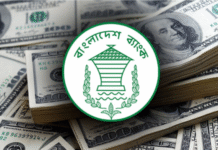Bangladesh’s economy has achieved an average growth of over 6 percent over the past five years primarily due to the healthy flow of remittance and rising exports.
Both exports and remittance flow from expatriate Bangladeshis have doubled over the last five years despite many hurdles.
The foreign currency reserve has increased two and a half times, again due to rising exports and remittance flow.

Economists say exports, remittances and foreign reserves have come to form a growth triangle that helped Bangladesh pull a large part of its population out of poverty and help it achieve UN targets two years in advance.
For the first time since independence from Pakistan, Bangladesh has a current account surplus of $2 billion plus.
A buoyant economy gives Bangladesh the confidence to even decide to fund the $2.9 billion Padma bridge, the country’s biggest ever infrastructure project, with its own resources.
Finance Minister Abul Maal Abdul Muhith is overjoyed.
Speaking to bdnews24.com, he said Bangladesh’s economy had developed over the past five years despite various challenges like the global economic downturn and the country’s volatile politics, with frequent strikes affecting both output and marketing.
“We can do nothing with the worldwide economic depression which has not gone away fully,” he said.
“Then there was political instability. The opposition-enforced harmful programmes such as shutdowns and blockades have affected the economy to a great extent,” he said.

“Despite everything, remittance, export income and reserve have increased in the past five years which have strengthened the base of our economy,” the Finance Minister said.
He observed few countries could achieve an average 6 percent annual growth in the past five years — or maintain it once achieved.
According to latest Bangladesh Bank statistics, the remittance kitty touched $14.18 billion seven days before the current fiscal ended – nearly 15 percent higher than the same period last year.
Remittance this fiscal would cross $14.6 billion once figures 2012-13 fiscal are added, said Kazi Saidur Rahman, General Manager of the central bank’s Foreign Exchange Reserve and Treasury Management Department.
Only five years ago, in the 2007-08 fiscal, remittance inflow stood at $7.9 billion. It has increased gradually ever since.
In the 2008-09 fiscal it rose to $9.9 billion, then by nearly $1 billion within a year. Remittance inflow was $11.65 billion in the 2010-11 fiscal and $12.84 billion in the last fiscal.
According to July 2012- May 2013 statistics, Bangladesh has earned $24.32 billion in export which is 11 percent higher than the same time previous year.
Experts say the amount would get close to $27 billion once the income in June is added.
In 2007-08 fiscal, Bangladesh had earned $14.1 billion from exports.
The exports increased by nearly $1.5 billion the following fiscal to $15.56 billion, then to $16.2 billion in the 2009-10 fiscal.
Bangladesh saw a boost of over $6.5 billion in the 2010-11 fiscal when the exports rose to $22.93 billion, again rising to $24.28 billion last fiscal.
On Monday, Bangladesh Bank’s foreign exchange reserve touched $15.25 billion for the first time in history.
It is possible to meet import demand of over five months with the current reserve, Kazi Saidur Rahman told bdnews24.com.
“We hope the remittance will cross $15.5 billion in the first week of July before payment of Asian Clearing Union (ACU) dues,” he said.
At the end of the 2007-08 fiscal the central bank’s foreign exchange reserve was $6.14 billion which increased to $7.47 billion at the end of the next fiscal.
By the end of 2009-10 fiscal, the amount increased to $10.75 billion. It was $10.36 billion at the end of 2010-11 fiscal and $13.07 billion in the last fiscal.

Zaid Bakht, Research Director of Bangladesh Institute of Development Studies (BIDS), said, “I think the expatriates had kept the economy booming in the past five years. Their remittance increased over the years despite political volatility in Libya, Egypt and other Middle Eastern countries.”
“In case of exports, there were problems of gas and power besides weak infrastructure. Apart from the fire at the Tazreen garments and huge loss of lives in the Rana Plaza collapse, the apparel sector is plagued with continuous labour unrest.”
“The European countries and America are reducing import of readymade garment products due to economic slowdown. Still, the export income is rising.”
He believes the foreign currency reserve has got a strong base thanks to the increased export income and buoyant remittance flow.
All in all, bright economics despite fractious, volatile politics – that’s the Bangladesh story.
Source: Bd news24









